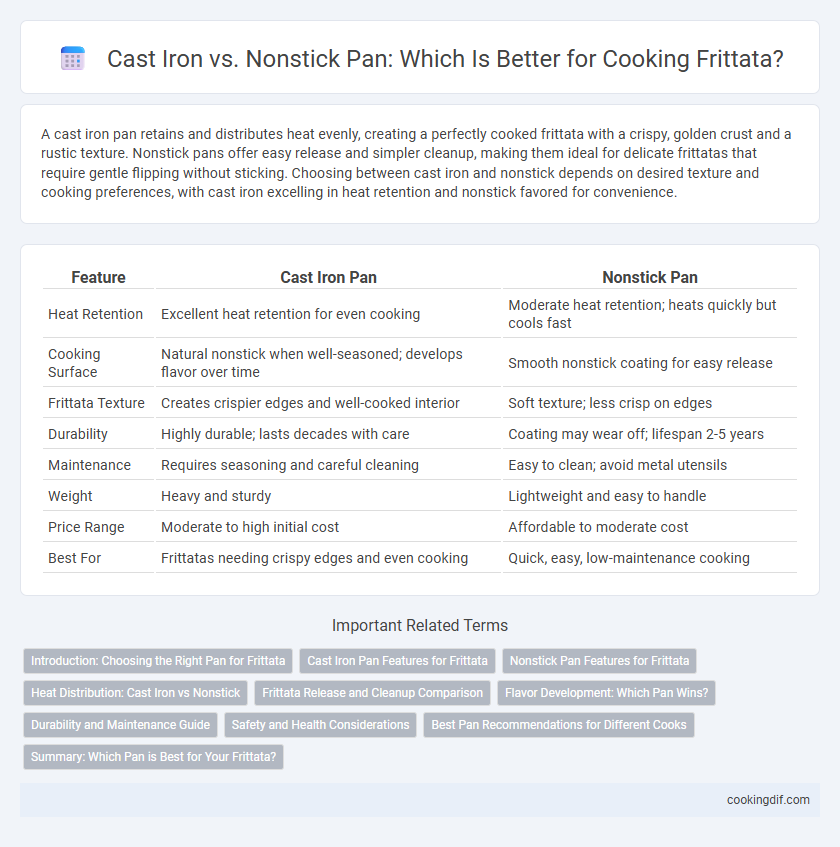A cast iron pan retains and distributes heat evenly, creating a perfectly cooked frittata with a crispy, golden crust and a rustic texture. Nonstick pans offer easy release and simpler cleanup, making them ideal for delicate frittatas that require gentle flipping without sticking. Choosing between cast iron and nonstick depends on desired texture and cooking preferences, with cast iron excelling in heat retention and nonstick favored for convenience.
Table of Comparison
| Feature | Cast Iron Pan | Nonstick Pan |
|---|---|---|
| Heat Retention | Excellent heat retention for even cooking | Moderate heat retention; heats quickly but cools fast |
| Cooking Surface | Natural nonstick when well-seasoned; develops flavor over time | Smooth nonstick coating for easy release |
| Frittata Texture | Creates crispier edges and well-cooked interior | Soft texture; less crisp on edges |
| Durability | Highly durable; lasts decades with care | Coating may wear off; lifespan 2-5 years |
| Maintenance | Requires seasoning and careful cleaning | Easy to clean; avoid metal utensils |
| Weight | Heavy and sturdy | Lightweight and easy to handle |
| Price Range | Moderate to high initial cost | Affordable to moderate cost |
| Best For | Frittatas needing crispy edges and even cooking | Quick, easy, low-maintenance cooking |
Introduction: Choosing the Right Pan for Frittata
Cast iron pans offer superior heat retention and even cooking, making them ideal for achieving a perfectly browned crust on a frittata. Nonstick pans provide easier release and quicker cleanup, which is beneficial for delicate eggs and preventing sticking. Selecting between cast iron and nonstick depends on your desired texture and ease of maintenance in frittata preparation.
Cast Iron Pan Features for Frittata
Cast iron pans provide superior heat retention and even cooking, essential for achieving the perfect frittata with a crispy, golden crust. Their natural nonstick seasoning improves over time, allowing frittatas to release easily without sticking. Durable and oven-safe, cast iron pans enable seamless stovetop-to-oven transitions, ensuring thorough cooking and enhanced flavor development.
Nonstick Pan Features for Frittata
Nonstick pans provide an even heat distribution essential for cooking frittatas without sticking or burning, ensuring a smooth, intact surface when serving. Their scratch-resistant coating allows easy flipping and cleanup, preserving the frittata's delicate texture and vibrant ingredients such as vegetables, cheese, and herbs. Lightweight construction enhances maneuverability, making nonstick pans ideal for achieving the perfect golden crust and creamy interior in frittata preparation.
Heat Distribution: Cast Iron vs Nonstick
Cast iron pans provide superior heat retention and even heat distribution, ensuring a consistent cooking temperature essential for a perfectly cooked frittata. Nonstick pans heat up quickly but may have hot spots, leading to uneven cooking and potential browning differences throughout the frittata. The thermal mass of cast iron helps maintain stable heat during oven finishing, while nonstick surfaces excel at preventing sticking but can sacrifice uniform heat.
Frittata Release and Cleanup Comparison
Cast iron pans offer superior heat retention and create a crispy crust on frittatas, but tend to require more effort for release and cleanup due to food adhesion and seasoning maintenance. Nonstick pans provide excellent frittata release, minimizing sticking and allowing effortless removal, which simplifies cleanup with minimal scrubbing needed. Choosing between cast iron and nonstick depends on the balance between desired texture and ease of maintenance for cooking and cleaning.
Flavor Development: Which Pan Wins?
Cast iron pans excel in flavor development for frittatas due to their superior heat retention and even cooking, which creates a richer, caramelized crust. Nonstick pans, while easier to clean, often lack the ability to build the complex Maillard reactions that enhance taste and texture. This makes cast iron the preferred choice for chefs seeking a deeply flavorful and perfectly browned frittata.
Durability and Maintenance Guide
Cast iron pans boast exceptional durability, often lasting decades with proper care, making them ideal for frequent frittata cooking. They require seasoning and careful cleaning to maintain their nonstick surface and prevent rust, demanding a maintenance routine involving hand washing and drying. Nonstick pans offer easier maintenance and quick cleanup but tend to have a shorter lifespan due to the coating wearing off, necessitating replacement every few years for optimal performance.
Safety and Health Considerations
Cast iron pans provide a natural non-toxic cooking surface free from synthetic coatings, reducing exposure to potentially harmful chemicals often found in nonstick pans. While nonstick pans offer ease of use, some coatings can degrade at high temperatures, releasing toxic fumes that pose health risks during cooking. Properly seasoned cast iron also adds beneficial iron to food, contributing to dietary iron intake without the concerns linked to chemical exposure.
Best Pan Recommendations for Different Cooks
Cast iron pans provide superior heat retention and even cooking, making them ideal for cooks seeking a rustic, crispy frittata crust and oven-to-table versatility. Nonstick pans offer effortless release and easy cleanup, suited for beginners or those prioritizing simple preparation and minimal oil usage. Choosing between cast iron and nonstick depends on cook experience, desired texture, and maintenance preference for perfect frittata results.
Summary: Which Pan is Best for Your Frittata?
Cast iron pans provide superior heat retention and even cooking, resulting in a crispy crust and thorough cooking for frittatas, while nonstick pans offer easy release and simpler cleanup. For achieving authentic texture and caramelization, cast iron is ideal, but nonstick is more convenient for quick preparation and minimal sticking. Choosing between the two depends on whether you prioritize texture and flavor complexity or ease of use and maintenance.
Cast iron vs Nonstick pan for cooking frittata Infographic

 cookingdif.com
cookingdif.com